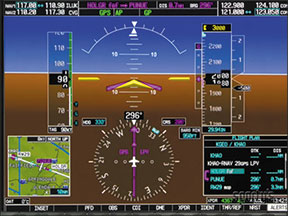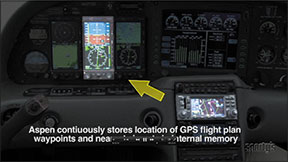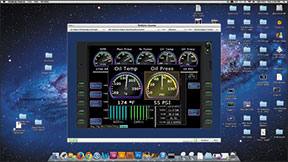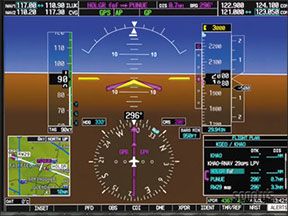Perhaps we should just admit resistance is futile. Glass cockpits look cool and make a lot of money for airframe and avionics manufacturers, They’re here to stay. But, with two-hour checkouts now becoming 10-hour events for glass newbies, what can you do to cut down on that $200-an-hour checkout dual so you can actually afford to rent and enjoy a 172 or Archer?

The good news is that there are good training courses for the G1000, Avidyne Entegra and Aspen Evolution in the form of DVDs, online courses, a book and apps. We looked at most of the commercially available courses—which ranged from good to excellent—although none will erase the need for in-airplane learning time.
The most expensive costs about 1.5 hours of dual—and we’re convinced they’ll save you more than that in time you don’t have to spend figuring out the buttons and knobs in the airplane with an instructor. We also found an app and a book that can help keep that hard-won knowledge about the G1000 from leaking out between flights.
Because the Garmin G1000 is the most common glass panel installation and has the most training courses, we’ll start with it.
ASA G1000 Course
Authored by Michael G. Gaffney, who also prepared ASA’s Avidyne Course, this 2013 computer-based tutorial is advertised to run on both a Mac and a PC. We could not make it run on a Mac due to software incompatibility, apparently due to the age of the course. It ran fine on a PC.
The course consists of 14 lessons, each broken into several sections that range from under a minute in length to nine minutes. While the course is organized to match the various functions and components of the G1000, there is an attempt to make the learning “real world” by integrating a particular use into the bigger picture of the G1000 system and how it may be used in flight.
The course starts at a very basic level—and is structured so the user can skip over what he or she already knows as we’ll as easily go back to cover a section again. Moving around within a section is via slider. The course is searchable and has a detailed glossary. There are quizzes at the end of each lesson—they vary in length, are scenario based and, in our opinion, do a good job of requiring the user have learned the material without going into trivia that will never be used. Passing each quiz with a score of 100 percent allows the user to obtain WINGS credit.
Within the slide-show styled course there are color-coded terms and figures that indicate more information is available or a figure is interactive. The narrator does read the text that appears in each slide, but goes into more detail than is presented in the text alone. A separate MP3 file on the CD allows listening to the narration away from a computer. ASA says the course takes four hours to complete. We agree with that number if you are not going to take advantage of the features.
While the course felt a little dated to us, we are of the opinion that for the $49.95 price it is an inexpensive way for a pilot to get a solid introduction to G1000 operations, shave an hour or so off the checkout and have a reference to keep her or his skills alive.

MAX TRESCOTT
At $34.95, Max Trescott’s G1000 and Perspective Glass Cockpit Handbook is one of the most comprehensive approaches to the G1000 we’ve seen. In 275 pages plus some useful appendices, Trescott walks the reader through a little-too enthusiastic introduction to the world of glass and then goes progressively through the G1000 systems, PFD, MFD, page system to information, instrument flying, failures and emergencies, advanced features and flying a trip behind a G1000 panel. He also goes into G1000 installations and operations in turboprops and light jets.
There are sidebars from time to time called “Tips,” and are just that—shortcuts, hints and passing along real-world experience in flying the G1000 as we’ll as differences between the original G1000 and the Perspective. The depth and extent of the secrets from experienced users is unusual in “how to” presentations, and something we value.
The presentation is tight, the writing crisp and the individual sections within the chapters are kept to a single component, concept or task, which makes for fast scanning when using the book as a reference. We also liked that Trescott identifies errors pilots commonly make when using the G1000—which may force the readers to come up with new ones.

The final chapter is devoted to flying the G1000 Perspective. The appendices include what we believe is handy information, including: difference by airframe manufacturers in G1000 warnings, cautions and engine instrumentation as we’ll as a comparison of the G1000 with the GNS 430 and GNS 530, the latter truly helpful to someone new to glass but with experience with Garmin’s GPS navigators.
Trescott’s website advertises a $99.95 VFR and IFR Garmin G1000 CD-ROM course which we ordered with the intention of reviewing. After placing our order, we were contacted and told that the CD-ROM course is “out of print and not available.”
Jeppesen
The $199.95 and $299.95 prices for, respectively, the “Core & VFR Procedures” and $299.95 for the IFR and VFR bundle—Jeppesen’s G1000 CDs— initially put us off. However, once we got the CD loaded (PC only, no Mac) and activated (it took a phone call to customer service), we found that the content was impressive. The course didn’t mess around with filler. There was a clear, concise briefing on how things worked (unfortunately, once we got into the course, we found we couldn’t get back into the briefing to refresh our recollection). Then it went right into how to use the G1000—explaining the why as the lesson goes along. Theory is nicely mixed with practice.
The animated graphics are absolutely first rate, clearly showing the G1000 as it looks in flight and carefully highlighting the knob, button or section of a screen of interest. They’re configured for a Diamond DA-40 and look real.
Other than the introductory segments, most sections start out with a demo that explains the particular functions and operations. It’s followed by a training section where you use a simulator, as the course has you conduct a series of tasks, such as calling up a particular page, finding and entering frequencies (click and drag because you can’t grab a knob—it works well). It prompts you with red arrows to help you get it right.
Finally, there’s a test—Jeppesen refers to the section as “solo”—and it’s not the usual, easy multiple-choice pablum. It’s as realistic as it can get on a computer version of a panel simulator—you are facing the panel and are directed to accomplish another series of tasks having to do with the segment—except that you are not given any prompts. You’ve got to use the controls correctly to get through the series. If you make a wrong input, you’re told that it’s an error—although it doesn’t take you into a new, wrong page or software never-never land as it might in real life—and you try again. Once you get it right, the sequence moves on. More than two errors and you don’t get credit for the test.
You can’t nod off and then fake your way through this course. You watch the system in action while listening to a narrator that actually uses voice inflection (you can read the script if you wish, but there’s usually a lot to watch on the panel), then you interact with the G1000 with guidance and finally, you do it on your own.
We think that making the effort to work your way through this course at a level where you pass all the exams is going to save you real time and money on the aircraft in your G1000 checkout.
King Schools
King Schools offers its G1000 course either online or through an interactive DVD course for PC (no Mac). Broken down into lessons, called labs, made up of video snippets, each with a quiz at the end, the course covers both VFR and IFR operation of the G1000. The price, either online or DVD, is $249.00. The quality is very good; the overview does not get overly tangled up with minutiae of the system, but goes directly into the how and why of operating it.
You can skip around among lessons and video snippets and use a slider to go to a specific area in a video snippet you wish to review.
The quizzes use what the Kings refer to as a Procedures Trainer in which you answer questions by drawing lines from the question box to the appropriate button or point on the PFD or MFD or click on arrows to rotate the knobs. A wrong action generates a box explaining the correct answer or action and a link to the section of the video snippet that covers the question, something we liked. The use of the procedures trainer for the quizzes is a slick arrangement, although not as sophisticated and challenging as Jeppesen’s simulator and method of directed practice first and then testing without prompts.
From the standpoint of recurrent training and review, rather than initial training, we think the King quizzes with a direct link to the relevant portion of the video snippet is maybe a little better than the Jeppesen course.
Sporty’s
Sporty’s offers three versions of what it refers to as a Garmin G1000 Checkout Course: online, on DVD or as an app for an iPad or iPhone. The app is $79.99; the online and DVD versions are $89.95. The only difference we could determine was that the downloadable PC trainer will not run on an iPad or iPhone, however, if you buy the app, Sporty’s provides information on downloading the trainer to a Windows PC.
The course is just under two hours long, broken into 16 video segments. We reviewed the app because we wanted to see how it worked on the smaller screen and wanted the portability. It did well; the videos and graphics are sharp and clear. You can easily move between video segments and use the slider to move within a video. There is a single, 28-question review quiz at the end of all the videos—the questions each have a direct link to the appropriate video section.
In addition to the videos, the software includes a copy of the G1000 Cockpit Reference Guide (all 256 pages), a training course outline for students and instructors and images of G1000 installations in various airframes.
In under two hours, the course does not come close to the depth of the King or Jeppesen courses, however, we felt it will get a new glass pilot we’ll down the road to understanding the G1000. We liked the ability to pull out our iPad when we had a few minutes and watch one of the videos.
Avidyne Entrgra
ASA’s Complete Avidyne Course, by Michael G. Gaffney, is a 14-lesson CD course that will run on a PC or Mac or directly off the CD. Each lesson is broken into a number of segments that vary from less than a minute to nearly 10 minutes. Because there is so much information to cover, the bite-sized nature of the segments help to keep a newbie to glass from being overwhelmed.
After starting with the very basics of glass (a little too basic, we believe), including defining Technically Advanced Aircraft, how to scan, using checklists, warnings to keep one’s head out of the cockpit and a system overview; the course is organized to walk the user through the various facets of the Entegra, including its controls, the PFD, MFD, engine monitoring, the associated transponder, audio panel and autopilot as we’ll as flight planning, instrument procedures and emergency management.
It’s a slide-show presentation, with on-screen text, and while the narration is a little dry, at least the narrator does not simply read the displayed text—he goes into more detail.
There is no requirement to progress through every section or even take the lessons in order. WINGS credit can be obtained by successfully completing the quiz at the end of each lesson. For us, the quizzes did a satisfactory job of walking the line between too easy and requiring memorization of inconsequential details.
The course includes a detailed glossary that can be accessed easily in the middle of a lesson or for reference. The course is also searchable. Exploring the “About” section of the course turns up a link to the Entegra Freeplay Simulator, which the author of the course recommends downloading to practice the skills learned in the course.
The Freeplay simulator is from 2007 and is compatible with Windows XP, not Macs.
For $49.95, we liked this course as a solid introduction to the Avidyne Entegra system and an easy reference, although it is now five years old and has not been updated.
Aspen Evolution
As with Avidyne, there is a dearth of training programs for the Aspen Evolution—the only ones we found were from Sporty’s—online, on DVD and an app. The online course is $31.95, DVD $29.95 and app $29.99. It’s 1:30 of good-quality video without a way to skip to specific segments and does not have a table of contents—to navigate, it’s a matter of fast forwarding. There are no quizzes.
While this is the weakest of all the training programs we reviewed, it did cover the wide range of installations (one to three screens of the Aspen). We nevertheless believe that it should be watched by anyone intending to fly behind the Evolution.
YouTube
Not surprisingly, there are videos on YouTube with some degree of glass training—although not many, and what there exist are limited to the G1000. None of them, in our opinion, are in-depth enough to give more than an introduction to the G1000, although the one by Dick Rochfort, at an hour long, is the best of the bunch and worth the time to watch. Hey, it’s free.
Conclusion
When it’s time to go glass, we recommend any of the courses we reviewed. It’s a close call as to which is the best of the G1000 courses, but we think Jeppesen wins by a nose because of the more rigorous directed practice and testing. For keeping our skills up, all are satisfactory, although we found that for quick reference at home we went to Max Trescott’s book; away from home we used the Sporty’s app.


